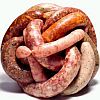So my sausage supply store only carries Danisco starter cultures and no Bactoferm. I purchased the Texel SP Elite, 20 gram package for 200kg of meat. Has anyone used this product? I'm assuming I would use it the same way as bactoferm and dissolve it in distilled water and 1 gram would be for 10kg of meat? My digital scale doesn't do less than a gram (I know I need a drug dealer scale).
Some sources like Charcuterie claim you should use more than the amount on the package to make sure it works. Is this necessary? Would it actually affect the outcome if I used more than the recommended amount? Like 1 gram for 2kg of meat? The woman at the company says this can be used the same as bactorferm and recommended the flavour of this specific culture so I hope I made the right choice, lol.
Danisco Starter Culture Question
12 posts
• Page 1 of 1
Anyone able to help? Am I safe using 1gram of the 20gram packet for 2kg of meat? Or should I use more? I know with products like bactoferm they suggest a quarter of a pack to be certain it works. Is this necessary?
I'm hoping to start some chorizo but I wanted to be sure before I start.
I'm hoping to start some chorizo but I wanted to be sure before I start.
-

ComradeQ - Registered Member
- Posts: 332
- Joined: Mon Dec 31, 2012 3:27 am
- Location: Toronto, Canada
I don't know for sure, but I think that the recommendation to use more than the pro-rata amount when not using the full packet, is based on ensuring that there is enough active culture in the portion you use.
I'd err on the side of caution and use 2gm.
HTH
Phil
I'd err on the side of caution and use 2gm.
HTH
Phil
-

wheels - Global Moderator
- Posts: 12891
- Joined: Sat Sep 02, 2006 4:29 pm
- Location: Leicestershire, UK
I agree with Wheels. The amount of acid produced is mostly dependent on the amount and type of food you provide the bacteria. The time it takes to get the fermentation to completion is mostly dependent on the number of bacteria and the temperature. You might want to check the "use by" date on the package as well.
Fashionably late will be stylishly hungry.
- NCPaul
- Site Admin
- Posts: 2922
- Joined: Thu Oct 01, 2009 12:58 am
- Location: North Carolina
Good stuff! So I will take your advice and use 2grams for the chorizo. I'm not positive where I will hang it for the 12 hour initial fermentation, thinking maybe over my stove with an element on and a big pot of water simmering for the humidity. Anyone try this or have other suggestions?
-

ComradeQ - Registered Member
- Posts: 332
- Joined: Mon Dec 31, 2012 3:27 am
- Location: Toronto, Canada
wheels wrote:It wouldn't be my choice. How about hanging them in a cardboard box in your warmest room? - airing cupboard? - with a wet towel in the bottom?
Phil
How about in my curing fridge if I turn it off and let it warm up? I have high humidity there already and when it is warm it sits at about 22°c. Then I can just turn it on, set it to 12°c, and leave them in while it cools.
The warmest room is probably only 21°c
-

ComradeQ - Registered Member
- Posts: 332
- Joined: Mon Dec 31, 2012 3:27 am
- Location: Toronto, Canada
wheels wrote:Sounds like a plan to me!
I am gonna hook a bulb up since I have a heat/cold temp controller rigged up and figured it could use that to keep it warm for the fermentation period. Last question for now (I promise, lol) does it matter if I don't use a surface culture for the chorizo? I didn't want it to have a mold coating when done so I figured I could bypass it and just wash it down if I see any signs of bad mold. Is a vinegar/water solution best for that or do you suggest something else?
-

ComradeQ - Registered Member
- Posts: 332
- Joined: Mon Dec 31, 2012 3:27 am
- Location: Toronto, Canada
For bad mold most on here use vinegar diluted with some water. Just know that isn't a "cure" and you will likely have to watch and redo several times.
Occupation?? Part time Butcher, Chef, Microbiologist, Scientist and Meteorologist – does what pays the bills really matter?
Eric
Eric
- ericrice
- Registered Member
- Posts: 197
- Joined: Fri Jan 06, 2012 2:55 pm
- Location: Philadelphia
Thanks for the great advice! So I am harvesting some surface mold cultures to spray on my chorizo in the morning. Figured I should be safe rather than sorry. The thing is I'd rather not have a finished chorizo with a white mold coating on it. So after it is ready, what is the best way to remove the mold? Or should I just bypass the surface culture and just keep mold from growing by wiping it down?
-

ComradeQ - Registered Member
- Posts: 332
- Joined: Mon Dec 31, 2012 3:27 am
- Location: Toronto, Canada
12 posts
• Page 1 of 1
Who is online
Users browsing this forum: No registered users and 18 guests

